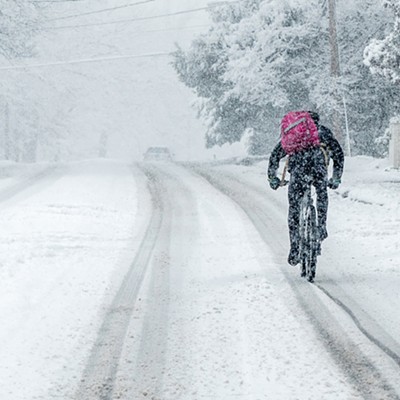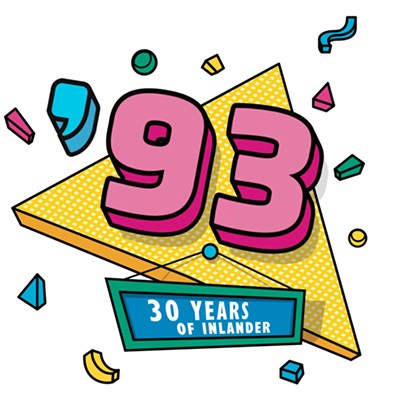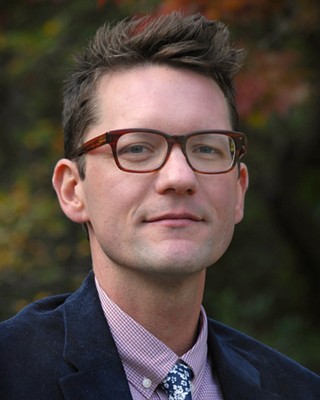All Grown Up
[
{
"name": "Broadstreet - Instory",
"insertPoint": "5",
"component": "25846487",
"requiredCountToDisplay": "5"
},{
"name": "Broadstreet - Instory",
"insertPoint": "10",
"component": "25846487",
"requiredCountToDisplay": "10"
},{
"name": "Broadstreet - Instory",
"insertPoint": "15",
"component": "25846487",
"requiredCountToDisplay": "15"
},{
"name": "Broadstreet - Instory",
"insertPoint": "20",
"component": "25846487",
"requiredCountToDisplay": "20"
}
]
by NICHOLAS DESHAIS & r & & r & & lt;span class= "dropcap " & W & lt;/span & hen Andy Dinnison opened Boo Radley's in the summer of '93, Dickie the Spinner plied the streets of downtown Spokane.
"What'd he spin?" a reporter asks Andy, imagining grand tricks involving dozens of plates or armies of tops.
"I believe he spun counter-clockwise," Andy laughs. "Wave his hand and spin, wherever he'd walk. Spin and walk, spin and walk. Now that Dickie's gone, you still see a lot of characters but you see a lot more people, too, who are enjoying downtown."
Since the days of Dickie the Spinner, a lot has changed in Spokane. But it's not just here. Stand on the highest points in downtown Spokane -- astride the Bank of America Financial Center, perhaps, or balancing on top of the Parkade's control tower -- and look east. It's one big city.
Newsflash: We live in a metropolitan area -- all of us, from the West Plains of Spokane to Coeur d'Alene's eastern flank. In the last 15 years, the region has boomed. Spokane County has added a new person to its rolls every two hours since 1993. That's 12 people -- whether baby, transplant or immigrant -- every day. More than $3 billion has been invested in the city's core, completely revamping its tumbleweed identity with projects such as River Park Square and the Davenport Hotel. Coeur d'Alene built 27 miles of bike paths as well as the $32 million Kroc Center, and North Idaho College received a $1 million grant for its Human Rights Education Institute.
But what happened between the cities easily rivals the good fortune of the region's hubs. In the last 15 years, the once quiet, bucolic hideaways of Spokane Valley, Liberty Lake and Post Falls have transformed into neighborhoods, shopping centers and more neighborhoods. In this time, Post Falls tripled its population and Liberty Lake had a tenfold increase in residents, growing from 600 to more than 6,000. The boom in between connected the two big cities in a frenzy of development, while the little, middle cities built identities all their own.
"It's a regional area," muses John Stone, who built the Riverstone complex in Coeur d'Alene. "People put up these artificial lines... but really, it's one region. We're really tied."
& lt;span class= "dropcap " & B & lt;/span & ill Gothmann remembers when his folks moved to Spokane Valley in 1955, right before he graduated from high school.
"My stepfather bought the northwest parcel on the corner of Sprague and Sullivan. Right in back of him was an apple warehouse. When I'd go up and visit him, we'd go up that dirty, dusty old road of Sullivan and go swimming," he says. Gothmann, a Spokane Valley city council member, says changes to Spokane Valley came gradually but really hit in the 1990s.
"The little towns of Dishman, Veradale, Opportunity and Greenacres fused. But we still refer to them separately," he says. Spokane Valley -- along with Liberty Lake and Post Falls -- blew up, rising like a floating bridge to connect the islands of Spokane and Coeur d'Alene.
In 1993, Spokane Valley and Liberty Lake were not cities. One was transforming from agricultural heartland to suburban hinterland, and the other was a lake community. Liberty Lake had about 600 residents and a general store. You drove through Spokane Valley. They both wanted a mall; only one got it.
"I think the thing that really changed the Valley, certainly the residential growth did, [but] the Valley Mall changed the growth here in a big way," says Scott Khuta, senior planner for the City of Spokane Valley. When the mall was built in 1997, the Valley turned the corner. Farm living was out. Shopping and commuting were in.
In 1993, the 38 square miles in the Valley were home to about 70,000 people. When the city incorporated in 2003 it immediately became the ninth largest city in the state. In five short years, it became the seventh. Almost 90,000 people live there now. From 2005 to this August, 1,648 new one- and two-family dwellings were built in the city. In Spokane, with more than twice the population, 1,795 dwellings were built.
"There's the sense that one has a little more space. Some may disagree with me, but there is that sense. We welcome newcomers, and I expect us to keep growing," Gothmann says. "One of these days we'll have a city center, I hope."
& lt;span class= "dropcap " & "I & lt;/span & f you could just experience walking along these streets -- with the abandoned buildings and broken windows like it was in '93 -- you'd know the difference," says Ron Wells, his Southern drawl slight after years in Eastern Washington. Wells, who helped pen Spokane's downtown plan, moved into his current office in 1993. "Three of these corners at First and Cedar were vacant. There was a lot of criminal activity around here day and night. That has changed," Wells says. And now there's the Steam Plant Grill, a Wells creation credited with helping jumpstart the downtown resurgence.
In all, some $3.5 billion has been invested downtown, including in the massive River Park Square. Where downtown commercial and residential occupancy rates hovered around 40 percent in the mid-'90s, now they're closer to 99 percent. And Saturday night? Well, ask Walt Worthy.
"Look around at 8:30 any night you pick. You see people, rather than not seeing people," Worthy says. Despite this, Worthy, who spent $30 million renovating the Davenport Hotel 10 years ago, isn't onboard the booster train. "I'm not surprised or disappointed [about what's happened in the last 15 years]. We're still selling ourselves short... It's deplorable seeing weeds that are six feet tall on every block. It just screams nobody gives a damn."
Knute Berger, a columnist for Seattle Magazine and former editor of Seattle Weekly, argues that something has changed in the Lilac City. In a recent article, Berger writes that Spokane has transformed from being among the "burgs full of left-behinds" to a city that is "not retro, but progressive, urban, close to nature." Berger also became smitten with our politics. "The Inland Empire might be red, but its capital is now purple, and turning bluer."
"One of the things that defined a new era in Spokane was when Tom Foley lost in 1994," says Lisa Brown, the state Senate majority leader who represents Spokane, of the longtime speaker of the U.S House of Representatives. "For a long period of time, I was the only Democrat this side of the Cascades... but I think it's shifting back," Brown notes.
One reason for this political shift is likely the tilting demographics. In 1993, 95 percent of Spokane County's population was white. Now, 89 percent of the county's residents are white, while most other groups of people -- black, Asian, Indian and Latino -- are growing. The fastest growing age demographic in the county is the 45-to-64 category, which went from 73,981 people to 118,847. Still, people between the ages of 25 and 44 remain the largest age group in the county. The largest five-year category, by far, is the 25-to-29 year olds, with 37,676 people. Second place goes to the 50-to-54 year olds, with 34,073.
& lt;span class= "dropcap " & I & lt;/span & n the early '90s, Coeur d'Alene was a dying lumber town with a growing collection of neo-Nazis on its outskirts. Now the city has a well-funded human rights center, 27 miles of bike paths connecting its neighborhoods and parks and expanding centers of higher education.
"We have just seen amazing changes here -- many, many for the good," says Mary Lou Reed, a former Idaho state senator from Coeur d'Alene. "It would have been impossible to imagine our skyline changing as much as it has."
In the last 15 years, Coeur d'Alene's population jumped from 28,313 to 42,265, an almost 50 percent hike. Spokane grew a meager 8 percent. Combining Coeur d'Alene with its two 'burbs, Hayden and Dalton Gardens, the total population reaches almost 60,000.
Reed says Idaho's panhandle has undergone an industrial shift in the last few years that created the Coeur d'Alene of today. Old lumber mills gave way to a golf course, the impressive Riverstone and, perhaps in the near future, an expansion of North Idaho College. "We are no longer based on the timber industry, but on information. I think that makes sense... it is the future," Reed declares.
Part of that information infrastructure is the Human Rights Education Institute, funded in large part by native Idahoan turned Internet entrepreneur and human rights advocate, Greg Carr. In 2001, Carr also helped purchase and raze the Aryan Nations complex, making way for a peace park.
& lt;span class= "dropcap " & "W & lt;/span & e have to adapt our vision of how we use things," Reed says, looking to the future. One of her favorite ideas is a light rail system running between Coeur d'Alene and Spokane. Most people agree with her, from Lisa Brown to Ron Wells to Mike Petersen, executive director of the Lands Council.
"I believe we'll see more people moving here than we even think is possible," Petersen says, adding that a good way to squish a bunch of people into a small space is through light rail. "Every stop would create a city center, every stop would be a downtown."
Bridget Piper, a local patron of the arts, says Spokane has to get ready for guests. "It reminds me of an old comfortable chair. It's got a great foundation. It was built to last. But now that company's coming, it needs some new stuffing, some new upholstery."
[email protected]
"What'd he spin?" a reporter asks Andy, imagining grand tricks involving dozens of plates or armies of tops.
"I believe he spun counter-clockwise," Andy laughs. "Wave his hand and spin, wherever he'd walk. Spin and walk, spin and walk. Now that Dickie's gone, you still see a lot of characters but you see a lot more people, too, who are enjoying downtown."
Since the days of Dickie the Spinner, a lot has changed in Spokane. But it's not just here. Stand on the highest points in downtown Spokane -- astride the Bank of America Financial Center, perhaps, or balancing on top of the Parkade's control tower -- and look east. It's one big city.
Newsflash: We live in a metropolitan area -- all of us, from the West Plains of Spokane to Coeur d'Alene's eastern flank. In the last 15 years, the region has boomed. Spokane County has added a new person to its rolls every two hours since 1993. That's 12 people -- whether baby, transplant or immigrant -- every day. More than $3 billion has been invested in the city's core, completely revamping its tumbleweed identity with projects such as River Park Square and the Davenport Hotel. Coeur d'Alene built 27 miles of bike paths as well as the $32 million Kroc Center, and North Idaho College received a $1 million grant for its Human Rights Education Institute.
But what happened between the cities easily rivals the good fortune of the region's hubs. In the last 15 years, the once quiet, bucolic hideaways of Spokane Valley, Liberty Lake and Post Falls have transformed into neighborhoods, shopping centers and more neighborhoods. In this time, Post Falls tripled its population and Liberty Lake had a tenfold increase in residents, growing from 600 to more than 6,000. The boom in between connected the two big cities in a frenzy of development, while the little, middle cities built identities all their own.
"It's a regional area," muses John Stone, who built the Riverstone complex in Coeur d'Alene. "People put up these artificial lines... but really, it's one region. We're really tied."
& lt;span class= "dropcap " & B & lt;/span & ill Gothmann remembers when his folks moved to Spokane Valley in 1955, right before he graduated from high school.
"My stepfather bought the northwest parcel on the corner of Sprague and Sullivan. Right in back of him was an apple warehouse. When I'd go up and visit him, we'd go up that dirty, dusty old road of Sullivan and go swimming," he says. Gothmann, a Spokane Valley city council member, says changes to Spokane Valley came gradually but really hit in the 1990s.
"The little towns of Dishman, Veradale, Opportunity and Greenacres fused. But we still refer to them separately," he says. Spokane Valley -- along with Liberty Lake and Post Falls -- blew up, rising like a floating bridge to connect the islands of Spokane and Coeur d'Alene.
In 1993, Spokane Valley and Liberty Lake were not cities. One was transforming from agricultural heartland to suburban hinterland, and the other was a lake community. Liberty Lake had about 600 residents and a general store. You drove through Spokane Valley. They both wanted a mall; only one got it.
"I think the thing that really changed the Valley, certainly the residential growth did, [but] the Valley Mall changed the growth here in a big way," says Scott Khuta, senior planner for the City of Spokane Valley. When the mall was built in 1997, the Valley turned the corner. Farm living was out. Shopping and commuting were in.
In 1993, the 38 square miles in the Valley were home to about 70,000 people. When the city incorporated in 2003 it immediately became the ninth largest city in the state. In five short years, it became the seventh. Almost 90,000 people live there now. From 2005 to this August, 1,648 new one- and two-family dwellings were built in the city. In Spokane, with more than twice the population, 1,795 dwellings were built.
"There's the sense that one has a little more space. Some may disagree with me, but there is that sense. We welcome newcomers, and I expect us to keep growing," Gothmann says. "One of these days we'll have a city center, I hope."
& lt;span class= "dropcap " & "I & lt;/span & f you could just experience walking along these streets -- with the abandoned buildings and broken windows like it was in '93 -- you'd know the difference," says Ron Wells, his Southern drawl slight after years in Eastern Washington. Wells, who helped pen Spokane's downtown plan, moved into his current office in 1993. "Three of these corners at First and Cedar were vacant. There was a lot of criminal activity around here day and night. That has changed," Wells says. And now there's the Steam Plant Grill, a Wells creation credited with helping jumpstart the downtown resurgence.
In all, some $3.5 billion has been invested downtown, including in the massive River Park Square. Where downtown commercial and residential occupancy rates hovered around 40 percent in the mid-'90s, now they're closer to 99 percent. And Saturday night? Well, ask Walt Worthy.
"Look around at 8:30 any night you pick. You see people, rather than not seeing people," Worthy says. Despite this, Worthy, who spent $30 million renovating the Davenport Hotel 10 years ago, isn't onboard the booster train. "I'm not surprised or disappointed [about what's happened in the last 15 years]. We're still selling ourselves short... It's deplorable seeing weeds that are six feet tall on every block. It just screams nobody gives a damn."
Knute Berger, a columnist for Seattle Magazine and former editor of Seattle Weekly, argues that something has changed in the Lilac City. In a recent article, Berger writes that Spokane has transformed from being among the "burgs full of left-behinds" to a city that is "not retro, but progressive, urban, close to nature." Berger also became smitten with our politics. "The Inland Empire might be red, but its capital is now purple, and turning bluer."
"One of the things that defined a new era in Spokane was when Tom Foley lost in 1994," says Lisa Brown, the state Senate majority leader who represents Spokane, of the longtime speaker of the U.S House of Representatives. "For a long period of time, I was the only Democrat this side of the Cascades... but I think it's shifting back," Brown notes.
One reason for this political shift is likely the tilting demographics. In 1993, 95 percent of Spokane County's population was white. Now, 89 percent of the county's residents are white, while most other groups of people -- black, Asian, Indian and Latino -- are growing. The fastest growing age demographic in the county is the 45-to-64 category, which went from 73,981 people to 118,847. Still, people between the ages of 25 and 44 remain the largest age group in the county. The largest five-year category, by far, is the 25-to-29 year olds, with 37,676 people. Second place goes to the 50-to-54 year olds, with 34,073.
& lt;span class= "dropcap " & I & lt;/span & n the early '90s, Coeur d'Alene was a dying lumber town with a growing collection of neo-Nazis on its outskirts. Now the city has a well-funded human rights center, 27 miles of bike paths connecting its neighborhoods and parks and expanding centers of higher education.
"We have just seen amazing changes here -- many, many for the good," says Mary Lou Reed, a former Idaho state senator from Coeur d'Alene. "It would have been impossible to imagine our skyline changing as much as it has."
In the last 15 years, Coeur d'Alene's population jumped from 28,313 to 42,265, an almost 50 percent hike. Spokane grew a meager 8 percent. Combining Coeur d'Alene with its two 'burbs, Hayden and Dalton Gardens, the total population reaches almost 60,000.
Reed says Idaho's panhandle has undergone an industrial shift in the last few years that created the Coeur d'Alene of today. Old lumber mills gave way to a golf course, the impressive Riverstone and, perhaps in the near future, an expansion of North Idaho College. "We are no longer based on the timber industry, but on information. I think that makes sense... it is the future," Reed declares.
Part of that information infrastructure is the Human Rights Education Institute, funded in large part by native Idahoan turned Internet entrepreneur and human rights advocate, Greg Carr. In 2001, Carr also helped purchase and raze the Aryan Nations complex, making way for a peace park.
& lt;span class= "dropcap " & "W & lt;/span & e have to adapt our vision of how we use things," Reed says, looking to the future. One of her favorite ideas is a light rail system running between Coeur d'Alene and Spokane. Most people agree with her, from Lisa Brown to Ron Wells to Mike Petersen, executive director of the Lands Council.
"I believe we'll see more people moving here than we even think is possible," Petersen says, adding that a good way to squish a bunch of people into a small space is through light rail. "Every stop would create a city center, every stop would be a downtown."
Bridget Piper, a local patron of the arts, says Spokane has to get ready for guests. "It reminds me of an old comfortable chair. It's got a great foundation. It was built to last. But now that company's coming, it needs some new stuffing, some new upholstery."
[email protected]





















